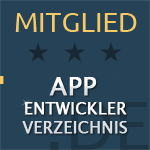
Insight

Insight

Insight
Flutter Web for Web Apps: Overcoming Challenges and Finding Effective Solutions


Julian Giesen
·
7
min read
·
Monday, November 18, 2024


Julian Giesen
Flutter has established itself as a versatile framework in app development, enabling cross-platform development for Android and iOS. With the introduction of web support for Flutter, an interesting opportunity has been created to utilize the same codebase for web apps as well. The advantage of this: developers can rely on a unified codebase that works on both mobile devices and in the browser. This is a significant advantage for companies and developer teams that want to save resources and quickly deploy their apps across different platforms.
Nevertheless, developing web apps with Flutter comes with some challenges, as Flutter was originally designed for mobile platforms. The requirements and standards for a mobile app differ in many ways from those that apply to web apps. A web browser behaves differently from a mobile operating system and often imposes additional demands on design and functionality. For instance, loading times and performance optimizations are particularly important in the browser, while on mobile platforms, hardware acceleration and native functionalities are often better supported.
Despite these challenges, Flutter offers a solid foundation for web development, especially through the use of Dart and the widget-based structure. This structure allows for the reuse of UI elements and ensures design consistency. At the same time, developers can benefit from a variety of widgets and animations that Flutter comes with by default and that work well on the web. With these fundamentals and a stable framework base, much can be achieved if one is aware of and addresses the specific requirements of the web browser.
In the following chapters, we will look at the specific challenges of adapting to the web browser, implementing responsive design, and accommodating different screen sizes—and how to effectively solve these issues to optimize performance and user experience in Flutter web apps.
Adapting Flutter Apps for the Web Browser
Adapting a Flutter app for the web browser presents some technical and conceptual challenges. Since Flutter was originally developed for mobile apps, it does not always work smoothly in the browser environment, where different requirements and standards apply. While mobile apps are often optimized for specific hardware, a web app must function consistently and performantly across various devices, browsers, and platforms.
Differences Between Mobile Apps and Web Apps in Flutter
A main difference lies in the rendering engine. Flutter uses a combination of HTML, CSS, and Canvas to render the widgets on the web, while on mobile platforms it can leverage hardware acceleration more effectively. This implementation can lead to performance differences, especially with complex animations or graphics-intensive content. Therefore, developers need to check whether their animations and interactive elements run in the browser without noticeable delays or jank. It can often be helpful to reduce animations or optimize them specifically for the web version.
Compatibility Issues with Different Browsers
Another point is browser compatibility. Different browsers interpret HTML, CSS, and JavaScript slightly differently, which can lead to inconsistencies in the app's design and behavior. Here, it’s important to conduct cross-browser tests and leverage tools like BrowserStack or similar solutions to verify functionality and appearance across various browsers (Chrome, Safari, Firefox, Edge, etc.). It is also advisable to integrate fallback solutions if certain features are not optimally supported in all browsers.
Optimizing the App Layout for Different Browsers and Platforms
In the web, the app layout can be influenced by various screen sizes and browser windows. Contrary to the relatively uniform use of mobile apps, web browsers are very flexible, and users can change the window size at any moment. Therefore, it’s essential to design the layout to be flexible and adaptable. Flutter offers a range of useful widgets like Flexible, Expanded, or AspectRatio that facilitate efficient implementation of responsive designs.
Additionally, the use of fonts and colors for the web view should be reviewed, as not all fonts and color contrasts work equally well on desktop and mobile devices. Close collaboration with the design team can help ensure a user-friendly and consistent presentation across all platforms.
Adapting a Flutter app for the web browser is not always trivial, but it is quite feasible. It requires technical knowledge about the differences between mobile platforms and web browsers as well as thoughtful layout and performance optimization. With targeted adjustments and a clear understanding of the peculiarities of the browser environment, it is possible to develop a stable and user-friendly web app with Flutter that is both functional and visually appealing.
Dealing with Responsive Design in Flutter
Responsive design is essential in web development, especially when apps need to look and function well on screens of various sizes, from small mobile devices to large desktop monitors. Flutter provides a flexible foundation for implementing responsive design but requires some specific adjustments and tools to ensure the best possible user experience.
Challenges in Implementing Responsive Design
One of the biggest challenges with responsive design in Flutter is adapting the app to dynamic screen sizes and orientations. Unlike native web technologies like CSS, where media queries are used to adjust layouts, a different approach must be taken in Flutter. Here, widgets are the central design element, meaning adjustments must be made directly within the code. This can be particularly challenging with complex layouts, as each element must respond individually to different screen sizes.
Using Breakpoints and Scalable Layouts
To make the layout flexible and user-friendly, the use of breakpoints is crucial. Breakpoints are predefined thresholds for screen width, beyond which the layout changes. In Flutter, these breakpoints can be set individually, for example, to automatically activate a single-column layout for smartphones when the width is less than 600 pixels and to switch to a multi-column layout for desktop views when the width exceeds 1200 pixels.
An easy way to implement breakpoints is to create different widgets or layout components for different screen sizes and display them based on the MediaQuery width. For instance, a three-column layout could turn into a two-column layout on tablets and a single-column layout on smartphones without sacrificing consistency or the user experience.
Utilizing MediaQuery and LayoutBuilder for Adjustments
MediaQuery and LayoutBuilder are two of the most important tools in Flutter for implementing responsive design:
MediaQuery: This object provides information about the current screen size and orientation. Using MediaQuery.of(context).size, the height and width of the screen can be determined and used to conditionally adjust widgets. This is particularly useful for dynamically adjusting sizes or spacing or deciding which widgets to display on smaller screens.
LayoutBuilder: This widget allows measuring the size of the parent container and rendering content based on that. LayoutBuilder is excellent for creating responsive layouts as it gives detailed control over how content adjusts based on the available space. This way, breakpoints can be defined, and widgets can be dynamically adjusted for different screen sizes.
By combining these two tools, the app can react to different screen sizes without the need for separate layouts for each screen size. With a thoughtful structure and well-defined breakpoints, a Flutter web app becomes significantly more flexible and adaptable.
Best Practices for Flexible and Dynamic Layout Design in Flutter
Using Flexible Widgets: Widgets like Flexible, Expanded, and Spacer help create layouts that adapt dynamically. They prevent content from being cut off on smaller screen sizes or the layout from becoming cluttered.
Breakpoints and Scalable Widgets: Similar to CSS with media queries, breakpoints can be defined in Flutter as well. With tools like MediaQuery and LayoutBuilder, conditional queries can be established to make layout changes at specific screen sizes. For instance, a three-column layout could be implemented on larger screens, while on smaller screens, it would automatically switch to a single-column view.
Avoiding Fixed Sizes and Pixel Values: Instead of using fixed pixel values for the size of widgets, it is advisable to utilize relative sizes or flexible designs. For example, the size of a widget can be tied to the width of the screen to ensure flexible display. This keeps the layout consistent and automatically adjusts to the available space.
Dealing with responsive design in Flutter is challenging but achievable with the right techniques and tools. MediaQuery and LayoutBuilder enable developers to create dynamic and flexible layouts that adapt to various screen sizes and devices. By employing flexible widgets and dynamic sizing, responsive apps can be created in Flutter that look just as good on the web as they do on mobile devices.
Successfully Using Flutter for the Web
Flutter offers an exciting opportunity to efficiently develop web apps with a consistent codebase as a cross-platform framework. Due to its versatile widget structure and strong UI performance, Flutter is well-suited to creating visually appealing, interactive, and adaptable web apps. However, using Flutter for web apps brings certain challenges that should not be underestimated. In this conclusion, we summarize the key insights and highlight when Flutter is suitable for web projects.
Summary of Main Solutions and Best Practices
To successfully utilize Flutter for web development, it is crucial to consider the peculiarities of the web browser and different screen sizes:
Adapting to the Browser Environment: Flutter web apps require special adjustments regarding performance and browser compatibility. Solid performance optimization, such as reducing complex animations and targeted resource management, helps ensure that the app runs smoothly in the browser.
Responsive Design and Layout: With tools like MediaQuery, LayoutBuilder, Flexible, and Expanded, responsive layouts can be created that adapt flexibly to different screen sizes. Breakpoints and dynamic layouts ensure that the app functions well on both desktop and mobile devices while remaining user-friendly.
When Flutter is Worth It for Web Apps
Flutter is particularly suitable for web apps when a unified codebase is needed for multiple platforms and the focus is on UI intensity. Web projects that require close integration with mobile apps or prioritize cross-platform consistency benefit from Flutter. Examples include dashboard applications, marketing tools, visualizations, and other interactive web applications.
When Alternatives Are More Sensible
For web apps that rely on extensive SEO requirements or server-side rendering, a native web framework like React or Angular may be more appropriate. Additionally, applications that require very specific browser compatibility or minimal overhead might be more efficiently implemented with conventional web technologies.
Outlook on Future Developments in Flutter for Web
Flutter is continuously being developed, and many of the current challenges in web support are being addressed in upcoming versions. Performance optimizations, improved browser compatibility, and an expanded set of responsive widgets are part of the roadmap that will make Flutter even more attractive for web development in the long term.
Conclusion
Despite its challenges as a web framework, Flutter offers significant advantages for developers seeking a unified, powerful solution for their apps. By using the mentioned techniques and best practices, responsive, performant, and user-friendly web apps can be created with Flutter. For companies and developers who focus on cross-platform development, Flutter remains an exciting choice—even for the web space.
All insights
All insights
“Flutter and the related logo are trademarks of Google LLC. We are not endorsed by or affiliated with Google LLC.”
“Flutter and the related logo are trademarks of Google LLC. We are not endorsed by or affiliated with Google LLC.”
Copyright ©2025. Julian Giesen. All rights reserved.
“Flutter and the related logo are trademarks of Google LLC. We are not endorsed by or affiliated with Google LLC.”






